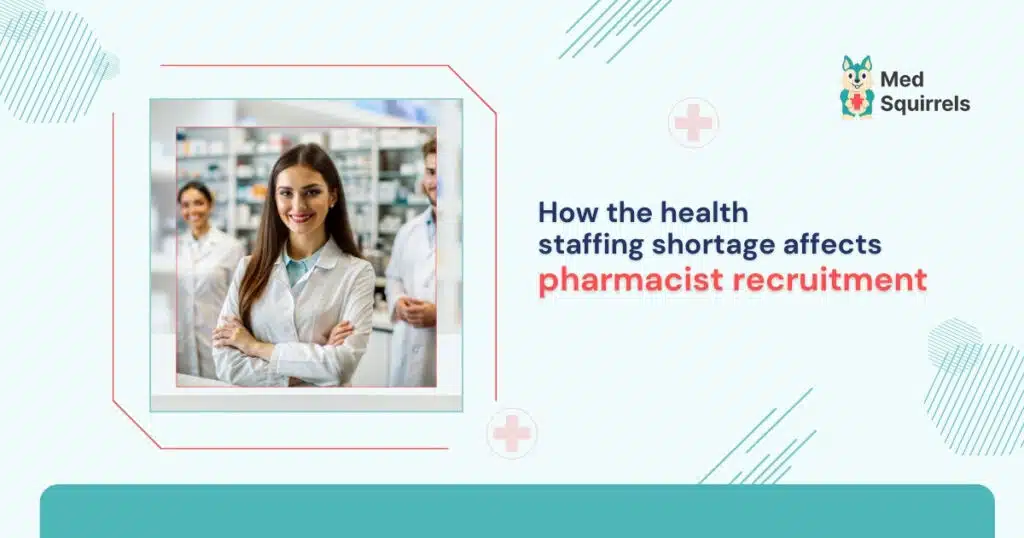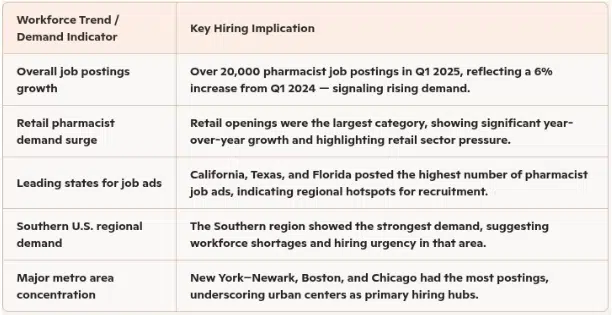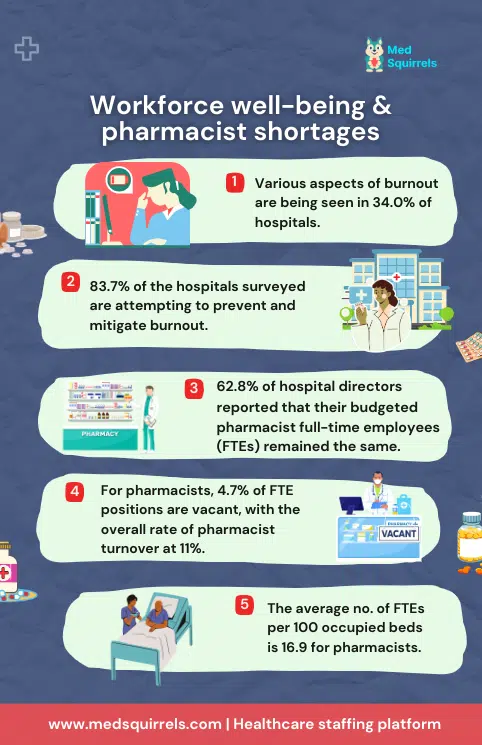How the health staffing shortage affects pharmacist recruitment

Pharmacists are one of the inevitable components of the healthcare ecosystem. The duties of the pharmacists not only include dispensing medicines and educating patients, but they also play an important role in the hospital’s drug house inventory management. With the right skilled pharmacists, your facility can save money while enhancing operational efficiency. You might have most likely seen reports about the shortage of various drugs in the news. Likewise, yet another pressing issue in the healthcare sector is the shortage of pharmacists. The World Health Organization (WHO) recommends a pharmacist-to-population ratio of one pharmacist per 2,000 people for optimal healthcare. However, the rising shortage of pharmacists is affecting the healthcare staffing industry as well as patient care.
The shortage of pharmacists in the USA is due to many factors, such as the COVID-19 immunization that leads to burned-out pharmacists, poor work-life balance, and unfair compensation packages, causing the early retirement of the workforce. This blog details how the healthcare staffing shortage is affecting pharmacist recruitment in healthcare facilities.
The growing demand for pharmacists
Pharmacists are in high demand in the USA. According to the Pharmacy Demand Report published by the American Association of Colleges of Pharmacy, 18,681 job postings are reported for pharmacists by the second quarter of 2024, which is significantly higher than the 14,200 yearly average job openings for pharmacists projected by the US Bureau of Labor Statistics .The pharmacists‘ job growth is projected to increase by 5% in the next decade. This highlights the growing demand for pharmacists in most of the states in the USA.
This growing demand for pharmacists especially affects healthcare facilities in underserved areas and non-metropolitan regions. With the increasing technological enhancements in the healthcare sector, pharmacists who are well-equipped to work alongside physicians to provide support with pharmacotherapy and dosage optimization are in high demand. Moreover, the rising awareness of chronic disease management among the public and the aging population has increased the number of patients in hospitals seeking preventive care treatments, including immunization.
Challenges in pharmacist recruitment
- Healthcare facilities in the USA are struggling to hire pharmacists due to their rising demand. The shortage of qualified pharmacists in the USA has caused a competitive job market where the facilities are compelled to offer a comprehensive compensation package above the market standards. This has caused some facilities to spend above their budget to hire the right pharmacists for them.
- The pharmacist hiring comes with a lot of regulatory complexities as the role demands working closely with patients and other allied healthcare professionals. An adverse drug event can cause a huge financial and reputational loss to the facilities. Hence, it is essential to navigate all the compliance challenges associated with pharmacist hiring.
- Another important challenge is the credentialing of potential candidates. A thorough credentialing needs to be done to ensure that the pharmacist hired does not have any pending drug abuse or criminal history. Credentialing also includes verifying the qualification, experience, and license of the pharmacist to understand whether he/she is eligible to work in the state where your facility is located.
- While discussing the pharmacist recruitment challenges, it is worth mentioning the retention challenges. Most of the new pharmacist recruitment challenges can be avoided if there is a proper retention strategy. The retention challenge includes providing career development opportunities, industry-standard pay, etc.
- The most important challenge is to adhere to the pharmacist licensure requirements and the scope of work listed by your state. This is subject to frequent revisions and the facilities must be aware of the latest rules imposed by the state to hire pharmacists.
What are the pharmacist licensure requirements in Alabama?
To hire pharmacists in Alabama, you must ensure your candidates satisfy all the conditions specified by the state and get the license. All Doctor of Pharmacy (Pharm.D.) graduates from accredited universities who have completed a minimum of 1500 internship hours are qualified to apply for the Alabama State Board of Pharmacy’s licensure. In addition, the candidate must pass the North American Pharmacist Licensure Examination (NAPLEX) and Multistate Pharmacy Jurisprudence Examination (MPJE) to ensure that the candidate has expertise in the technical and federal regulations related to the pharmacy domain. Once the application for the license is submitted, the board does a background verification of the candidate. There will be a final virtual interview of the candidate with the board members, after which the license to work as a Pharmacist in Alabama will be sanctioned. This license granted needs to be revised every two years to fulfill 30 hours of continuing education requirement.
Key metrics to track for successful pharmacist hiring in healthcare systems
To overcome healthcare staffing shortages, certain measures can be devised to navigate the challenges associated with pharmacist hiring. This can include creating more pharmacists’ employment opportunities by having a strong employer brand to attract top talented pharmacists to your facility by offering compelling benefits like salary and additional perks, including paid time-offs, flexible shifts, career development opportunities, etc. Moreover, retaining your existing pharmacists by providing them with the said benefits, establishing a clear career progression pathway, and implementing policies to support diversity and inclusiveness can help you decrease the staff turnover rate in your facility. The efficiency of all the above-said strategies can be tracked by considering the following key metrics for successful pharmacist hiring in healthcare systems.
- Time to hire pharmacists: This metric considers the average time taken to fill a pharmacist’s vacant role once it is published. The lower the hiring time, the more appealing the facility’s job description.
- Quality of hire: To understand the quality of the pharmacist hired, the performance evaluation can be done at regular intervals. It gives a clear picture of whether the pharmacist hired is competent enough.
- Offer acceptance rate: This metric indicates the ratio of the number of job offers accepted by the pharmacists to the number of job offers extended. This is also a good indicator of whether or not your facility stays on top of the competent pharmacist staffing market.
- Candidate source effectiveness: This metric is effective in crafting efficient recruitment strategies. It will help the facilities get an idea of the top sources (job boards, social media, etc) from where the vacancy was filled.
- Candidate experience feedback: Having a survey to collect feedback from the candidates regarding the recruitment process can help streamline any downsides in the facility’s hiring process.
- Job satisfaction level: This metric is particularly important to track successful pharmacist retention rates. The job satisfaction surveys can give you a clear picture of how satisfied is your current workforce, and the chances of staff turnover.
- Turnover rates: The pharmacist turnover rate can be calculated by taking the ratio between the number of pharmacists who resigned during a particular period to the average number of pharmacists during that period. The turnover rate is the best indicator to understand how the strategies adopted for staff retention are performing. According to the American Pharmacists Association the average rate of pharmacist turnover is 11% in the USA.
Pharmacy workforce trends and demand insights

Challenges in pharmacist recruitment in the USA
Healthcare facilities in the USA are struggling to hire pharmacists due to their rising demand. The shortage of qualified pharmacists has caused a competitive job market where facilities are compelled to offer comprehensive compensation packages above market standards. This intensifies the pharmacist staffing challenge and pushes some facilities to spend above budget to hire the right pharmacists.
- The pharmacist hiring process involves many regulatory complexities, as the role demands working closely with patients and other allied healthcare professionals. An adverse drug event can cause a huge financial and reputational loss to facilities. Hence, it is essential to navigate all compliance challenges associated with pharmacist recruitment.
- Another important challenge is the credentialing of potential candidates. Thorough credentialing is required to ensure the pharmacist hired does not have any pending drug abuse or criminal history. Credentialing also includes verifying qualifications, experience, and licenses to determine whether the pharmacist is eligible to work in the state where the facility is located.
- While discussing pharmacist recruitment challenges, it is worth noting retention challenges as well. Many recruitment problems can be avoided with proper retention strategies, such as career development opportunities and industry-standard pay.
- The most important challenge in pharmacist recruitment is ensuring compliance with your state’s licensure requirements and the scope of practice listed by your state. This is subject to frequent revisions, and facilities must stay up to date with the latest rules, especially in regions where a shortage of pharmacists is a concern.
State-by-state pharmacist licensure requirements
Before applying for any state license, pharmacists must understand that licensure rules vary widely across the U.S. Each state has its own eligibility criteria, renewal timelines, and regulatory expectations, so reviewing state-specific guidelines is essential before planning to work or relocate. This also ensures a smooth transition when moving from one state.
For instance, to hire pharmacists in Alabama, you must ensure the candidates satisfy all state-mandated conditions and obtain licensure.
All Doctor of Pharmacy (Pharm.D.) graduates from accredited universities who have completed a minimum of 1500 internship hours can apply for Alabama State Board of Pharmacy licensure.
Candidates must also pass NAPLEX and MPJE to demonstrate competency in technical and regulatory pharmacy practices.
Once the application is submitted, the board conducts background verification. A final virtual interview is held with board members, after which the pharmacist’s license is issued. This license must be renewed every two years to maintain 30 hours of continuing education.
Key metrics to track for successful pharmacist hiring in healthcare systems
To address healthcare staffing shortages, certain measures can be implemented to address the challenges associated with pharmacist hiring. This may include creating more pharmacist employment opportunities, building a strong employer brand, and offering compelling benefits such as competitive salaries, paid time off, flexible shifts, and career development opportunities.
Retaining existing pharmacists through clear career pathways and supportive workplace policies can significantly reduce turnover and relieve pressure on pharmacist staffing. The efficiency of these strategies can be measured using the following metrics:
- Time to hire pharmacists: Measures the average time taken to fill a pharmacist vacancy.
- Quality of hire: Evaluates the competency of newly hired pharmacists.
- Offer acceptance rate: Indicates the appeal of the facility’s compensation package.
- Candidate source effectiveness: Helps determine which recruitment channels yield the best pharmacist hires.
- Candidate experience feedback: Identifies improvements for the hiring workflow.
- Job satisfaction level: Tracks retention effectiveness and burnout risk.
- Turnover rates: A critical metric showing how well retention strategies are working.
There are several underlying factors driving today’s pharmacist shortage, and the infographic below clearly breaks them down for healthcare leaders.

By enabling pharmacy technicians to assume some of the clinical tasks that do not involve clinical expertise
and judgment could decrease pharmacist burnout by reducing exhaustion and extending care (i.e., improved personal efficacy), similar to the way in which the sharing of clinical duties with pharmacists reduces physician burnout.
Source:American College of Clinical Pharmacy
How MedSquirrels addresses pharmacist staffing shortage
MedSquirrels leverages technology to optimize strategies to address the pharmacist staffing crisis and the broader healthcare staffing shortage. By centralizing workflows and reducing operational bottlenecks, the platform helps facilities speed up their end-to-end pharmacist recruitment cycle.
- MedSquirrels uses AI technology to craft accurate job descriptions for your facility, improving pharmacist recruitment outcomes.
- The platform provides staffing solutions for full-time and contract hiring to support immediate staffing needs.
- MedSquirrels eliminates high markup fees typically charged by traditional agencies through a transparent pricing model.
- Facilities pay only a flat license fee plus pharmacist payroll based on the selected plan.
- The platform handles compliance and credentialing to ensure every pharmacist hired is qualified and state-ready.
With technology-driven workflows and an interactive dashboard, MedSquirrels streamlines the entire pharmacist recruitment process through its affordable staffing plans. You can book a demo to learn more.
FAQs
Is there a shortage of pharmacists?
Yes, several regions in the USA are experiencing a pharmacist shortage due to rising patient needs, expanding clinical responsibilities, and uneven workforce distribution. This makes it essential for facilities to offer competitive pay and clear career growth to attract qualified pharmacists.
Why is there a demand for pharmacists?
There is a growing demand for pharmacists due to rising prescription volumes, the expansion of clinical pharmacy services, and increased needs across retail, hospital, and outpatient settings. Pharmacists now play a larger role in patient counseling, medication management, and preventive care, which continues to elevate demand nationwide.
What are the common challenges in pharmacist recruitment?
Key challenges include talent shortages, high competition among employers, varying state licensure requirements, and lengthy credentialing timelines. Workload concerns and burnout also impact candidate availability.
What makes MedSquirrels cost-effective for pharmacist staffing?
Unlike traditional agencies that charge high markups, MedSquirrels operates on a transparent pricing structure with its affordable staffing plans. This allows facilities to control costs, forecast budgets accurately, and still access qualified pharmacists for full-time or contract roles.
How does MedSquirrels ensure compliance during pharmacist hiring?
The platform manages end-to-end compliance checks, including license verification, background screening, employment history review, and documentation tracking. Facilities receive real-time updates on each candidate’s compliance status, reducing risk and improving audit readiness.
